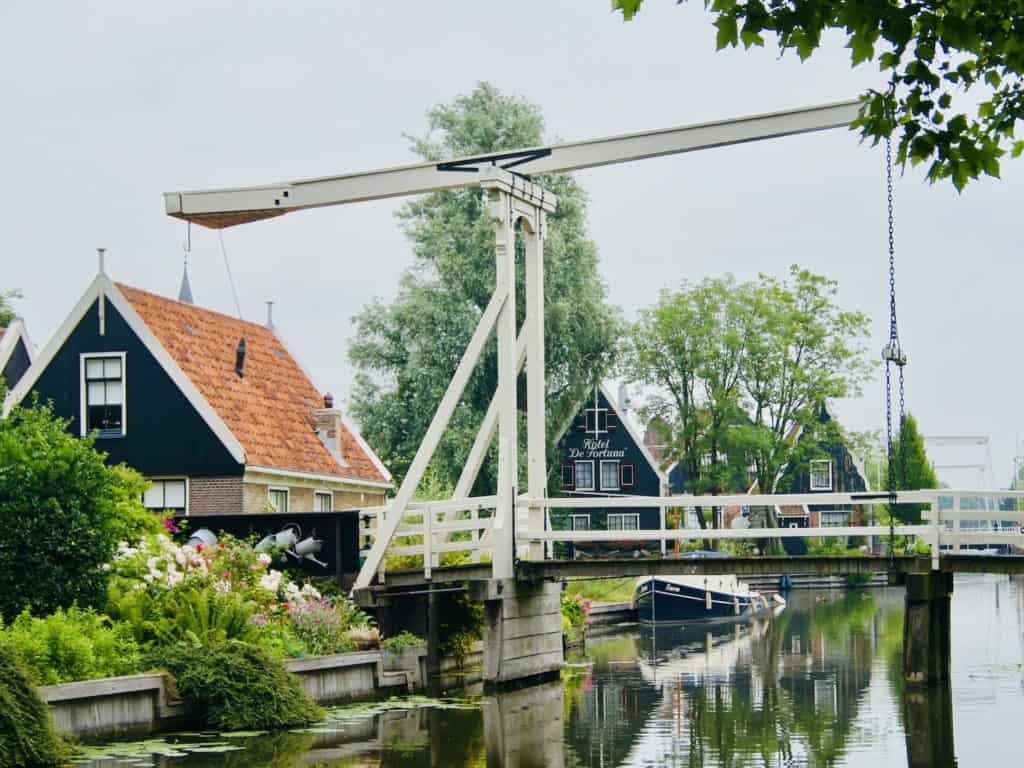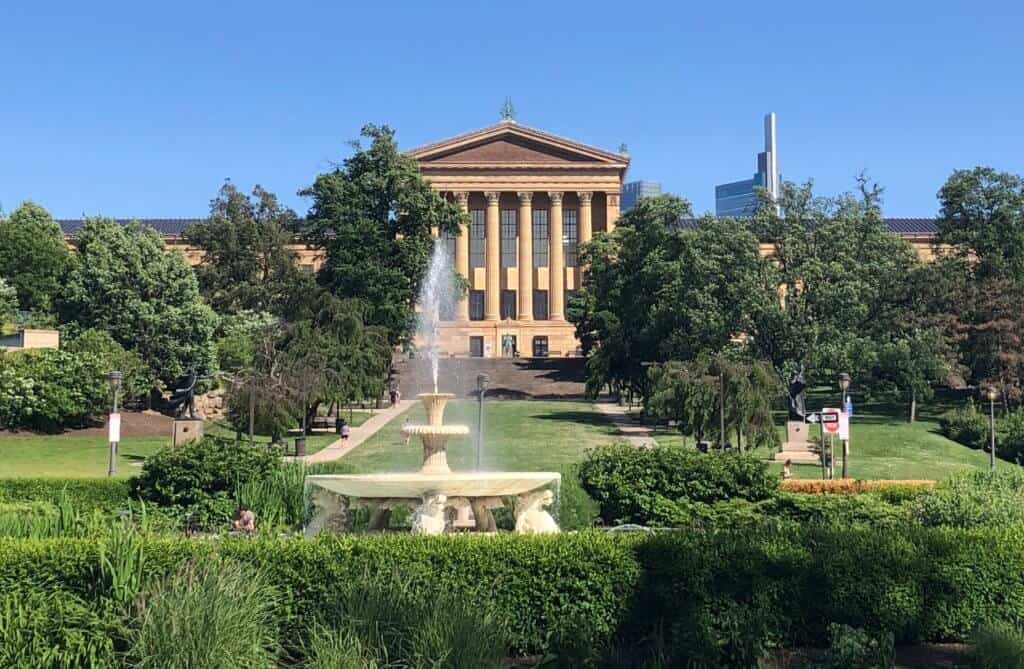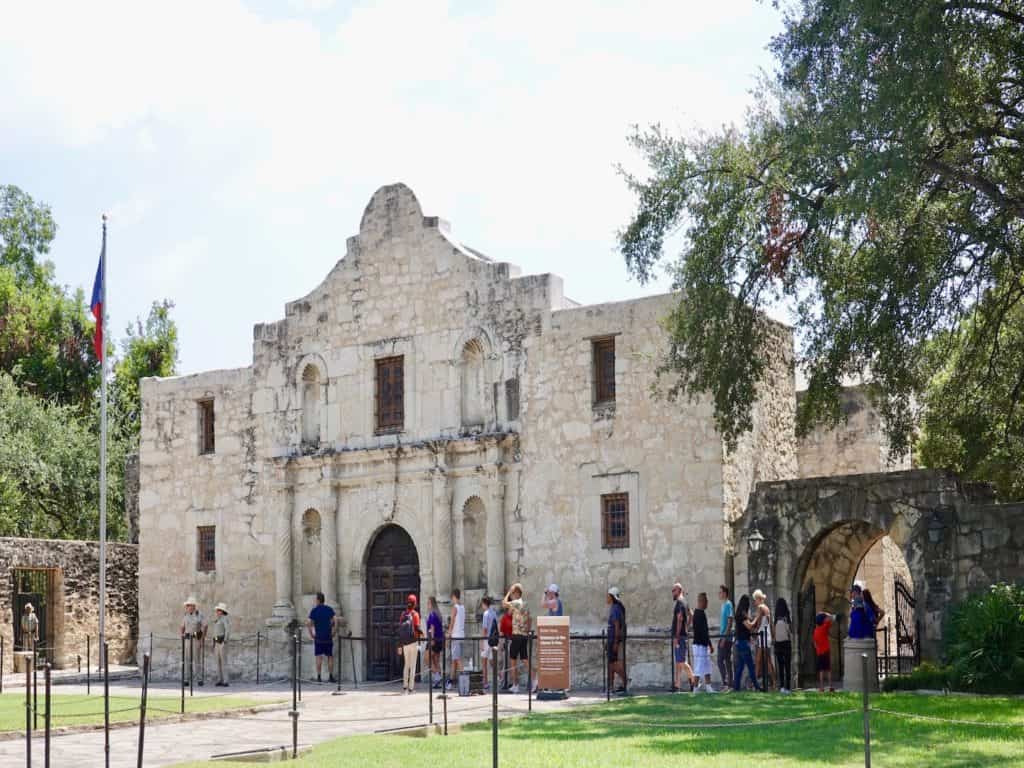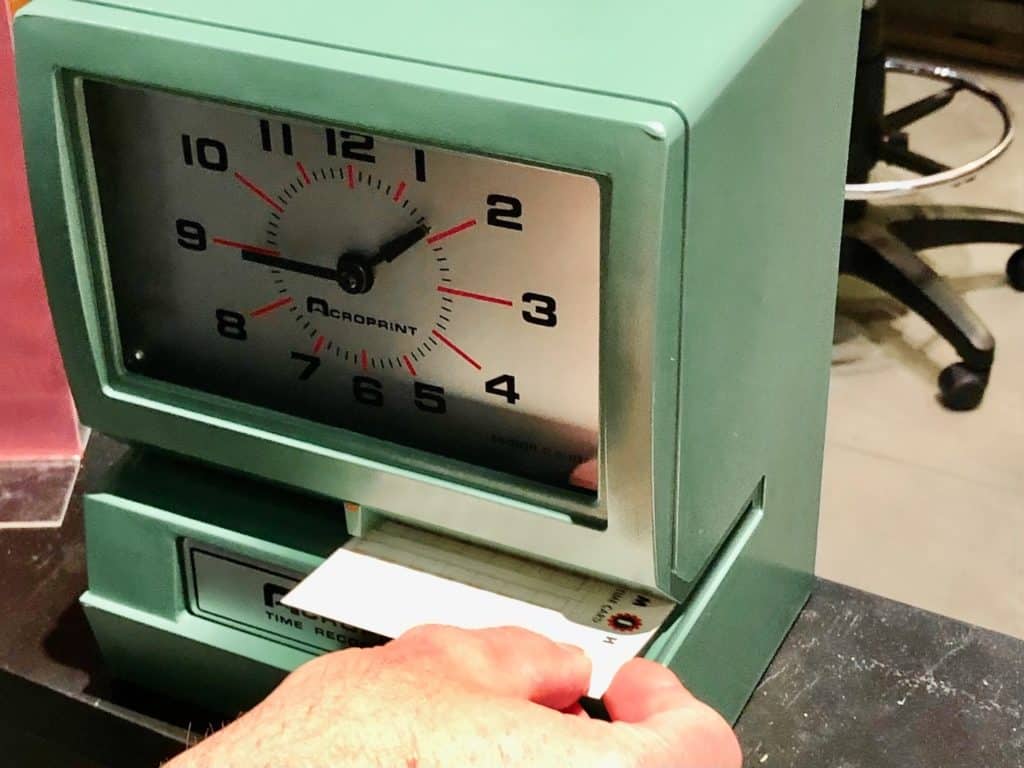What was life like for the wealthy merchant class (and their social peers) in 18th-century Philadelphia? Due to Philadelphia’s role in the colonial, revolutionary, and early independent governmental formation periods, this unique collection of homes relates important and intriguing stories from those consequential times. Visit some restored historical mansions in Fairmount Park along the banks of the Schuylkill River and learn of their unique histories during America’s colonial period. The homes are all located in Fairmount Park, an expansive area that hugs the western and eastern banks of the Schuylkill River. Besides the mansions, history buffs should check out Laurel Hill Cemetery, a great place to ponder the past, people who contributed to the country’s growth, and natural beauty. In addition, Fairmount Park has walking and biking trails, athletic fields, a horticultural center, an expansive zoo (the nation’s oldest), and a kid-friendly museum. I’ve visited Fairmount Park many times and appreciate its many attractions, be they historical, artistic, educational, and/or athletic.
Recently, I toured several of the mansions and enjoyed learning more about their early owners, their histories, as well as the homes’ architectural details, decor, and artifacts from that era. Note that not all the mansions are open at the time of publication; however, visitors can view each of them. Despite some mansion closures, they all have detailed informational signs outside, providing an interesting history of the structures and their owners.
Escaping Urban Life with a Country Retreat
Much of the property was farmland before being transformed into country estates, so some mansions started as modest farmhouses. In the 18th century, a trip from Philadelphia to one’s country estate would take about 60-75 minutes in a horse-drawn carriage. Having a country house allowed the wealthy to escape the downside of urban life, like the summer heat, disease, and crowds. It was common for the mansion owners to continue farming the land to provide for their families (and to sell excess goods in town).
The Birth of Fairmount Park
The City of Philadelphia purchased the historic homes and the surrounding properties in the mid-19th century to prevent land development and the resulting pollution that would affect the city’s water source, the Schuylkill River. The mansions were used for various purposes in subsequent years, including a beer garden, restaurants, and city park offices. Eventually, though, area organizations took over the stewardship of the buildings.
Today, various organizations (like the Philadelphia Museum of Art) are stewards of the mansions, preserving the homes and sharing their histories with the public.
This article highlights Fairmount Park’s historical mansions and other key spots.
Fairmount Park Map
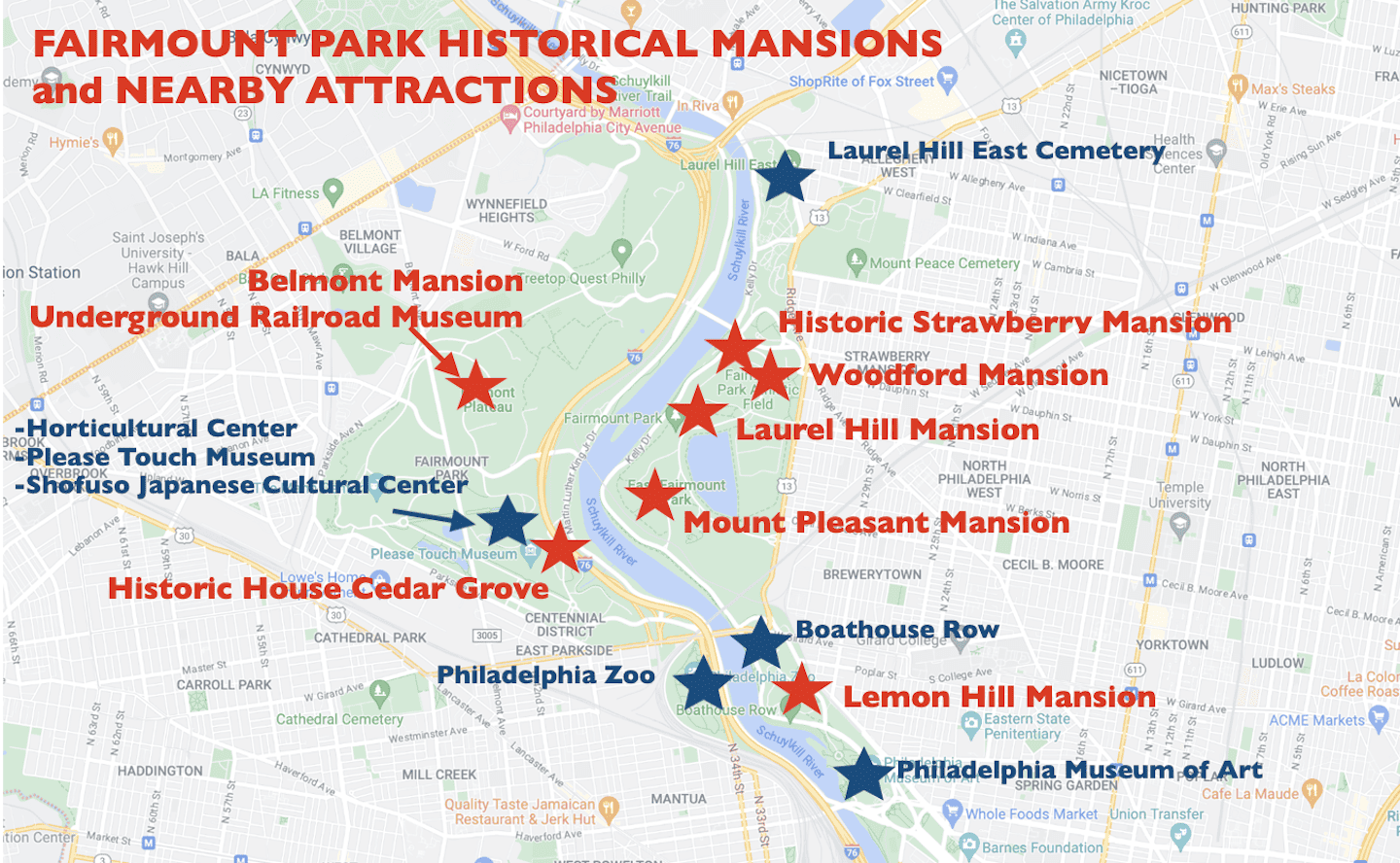
Fairmount Park Historical Mansions
Belmont Mansion
2000 Belmont Mansion Drive | 215-878-8844 | Open Tuesday-Thursday, 11:00 am-4:00 pm | Admission fee
English lawyer William Peters (also a land management agent for William Penn) purchased the land in 1742 and built the mansion in 1745. His son, Richard (a state senator, a judge, and an abolitionist), inherited the property after his father’s death. In addition to his professional pursuits, Richard Peters was interested in horticulture and operated the estate as a scientific farm. Among notable visitors to Belmont were George Washington, John Adams, Thomas Jefferson, and James Madison. Today, a visit to Belmont Mansion includes a self-guided tour of the Underground Railroad Museum.
Cedar Grove
1 Cedar Grove Road | 215-763-8100 (Philadelphia Museum of Art) | Currently closed (2023)
Mother of three children, Elizabeth Coats Paschall, built Cedar Grove in 1748 as her family’s home after the death of her husband. Five generations of the Paschall-Morris family lived in the Cedar Grove home, and the surrounding property was farmed. Over the years, the house was enlarged (including the addition of a parlor and a third floor). In 1926, Lydia Morris, the last surviving family member to live in the house, donated the home to the City of Philadelphia, and her home’s furnishings were given to the Philadelphia Museum of Art. Originally located in nearby Frankford (4 miles away), the house was moved to its current location in Fairmount Park at the time.
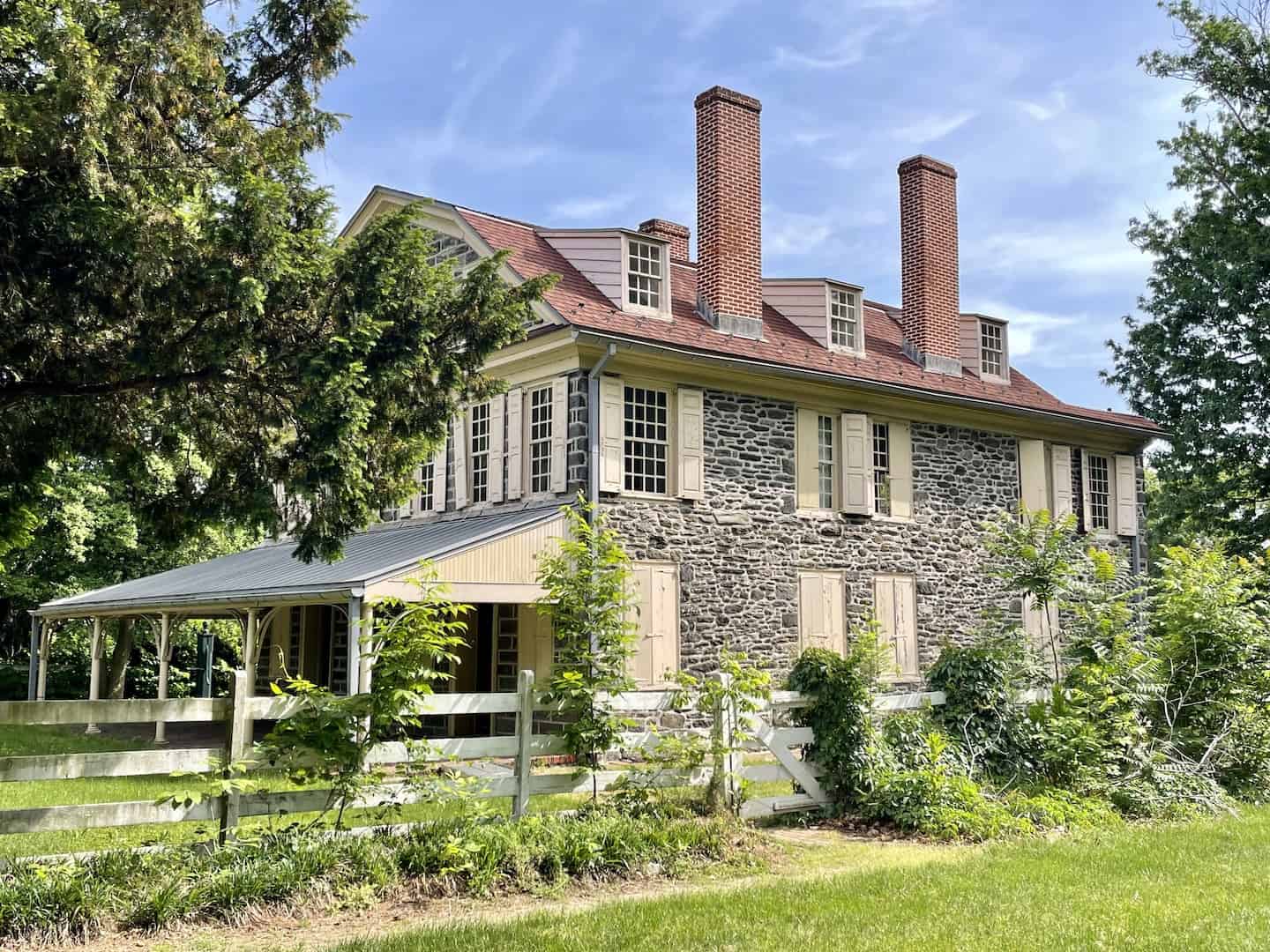
Contact the Philadephia Museum of Art (at the phone number listed above) to learn more about when the mansion will be re-opened.
Laurel Hill Mansion
3487 Edgley Drive | 215-235-1776 | Open Thursday-Sunday, 10:00 am-4:00 pm from April – December | Admission fee
The first owner, France Rawle, was killed in a hunting accident one year after purchasing the land in 1760. His widow, Rebecca, built the Georgian home in 1767 and soon after married her second husband, Samuel Shoemaker (a British Loyalist). During the American Revolutionary War, the Pennsylvania legislature tried Samuel for treason and seized the property. Samuel fled to England soon thereafter. Following the war, Rebecca worked to regain possession of the home (that rightly belonged to her). By 1791, Samuel returned from England, and the family continued to use the home during the summer months.
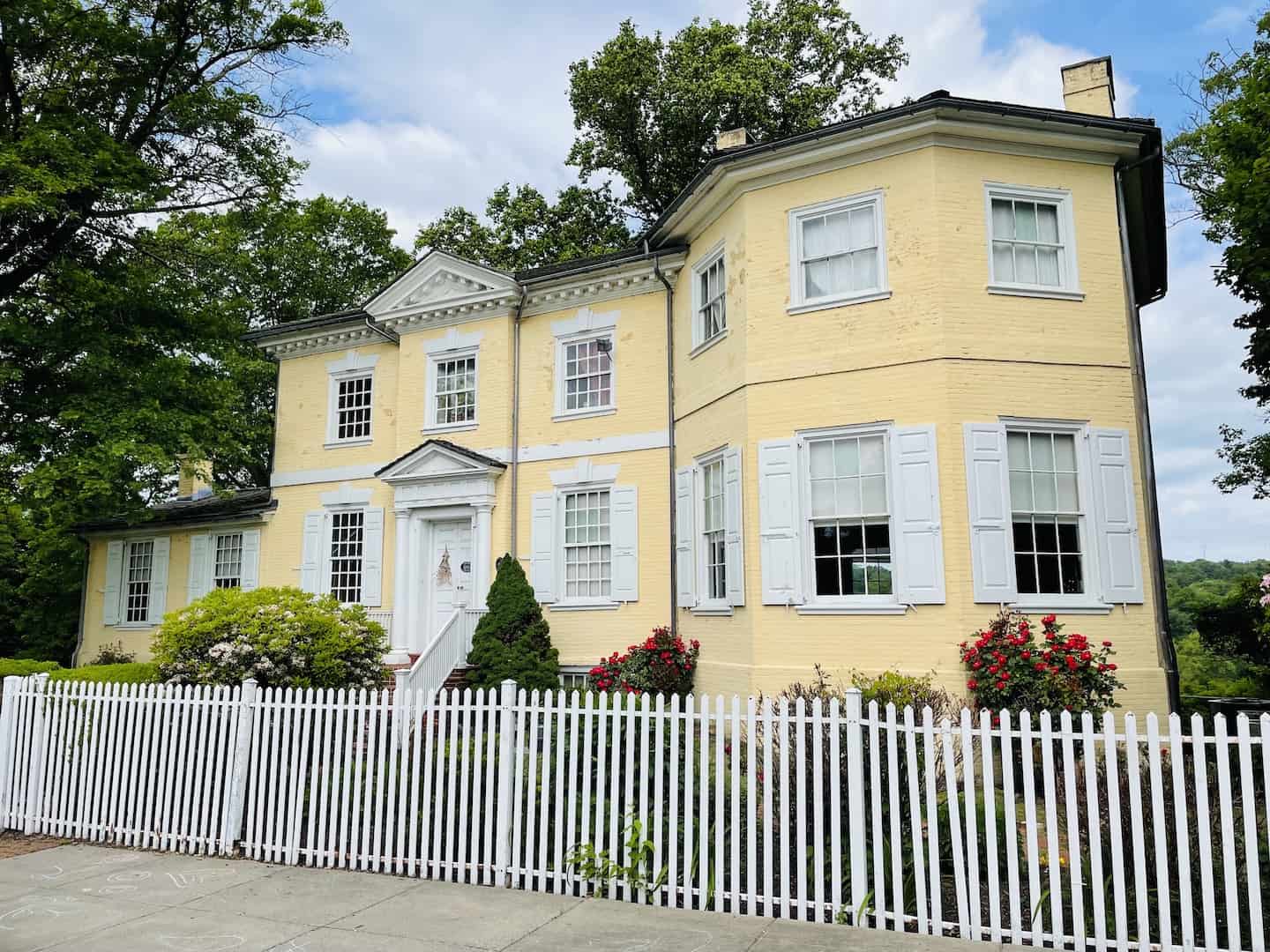
Rebecca’s son William inherited the property and sold it in 1820 to Philip Syng Physick, dubbed “The Father of American Surgery.” The Physick family added a sizeable octagonal wing used as a music room. It remained in the family until the City of Philadelphia purchased it in 1869.
View the Schuylkill River – and maybe even rowers on the water – from the home’s back porch. This is the one historical mansion property that offers excellent scenic river views.
A tour of Laurel Hill Mansion includes the first floor: the main room furnished as a dining room, the octagonal music room, a hallway, and an addition showcased as a kitchen.
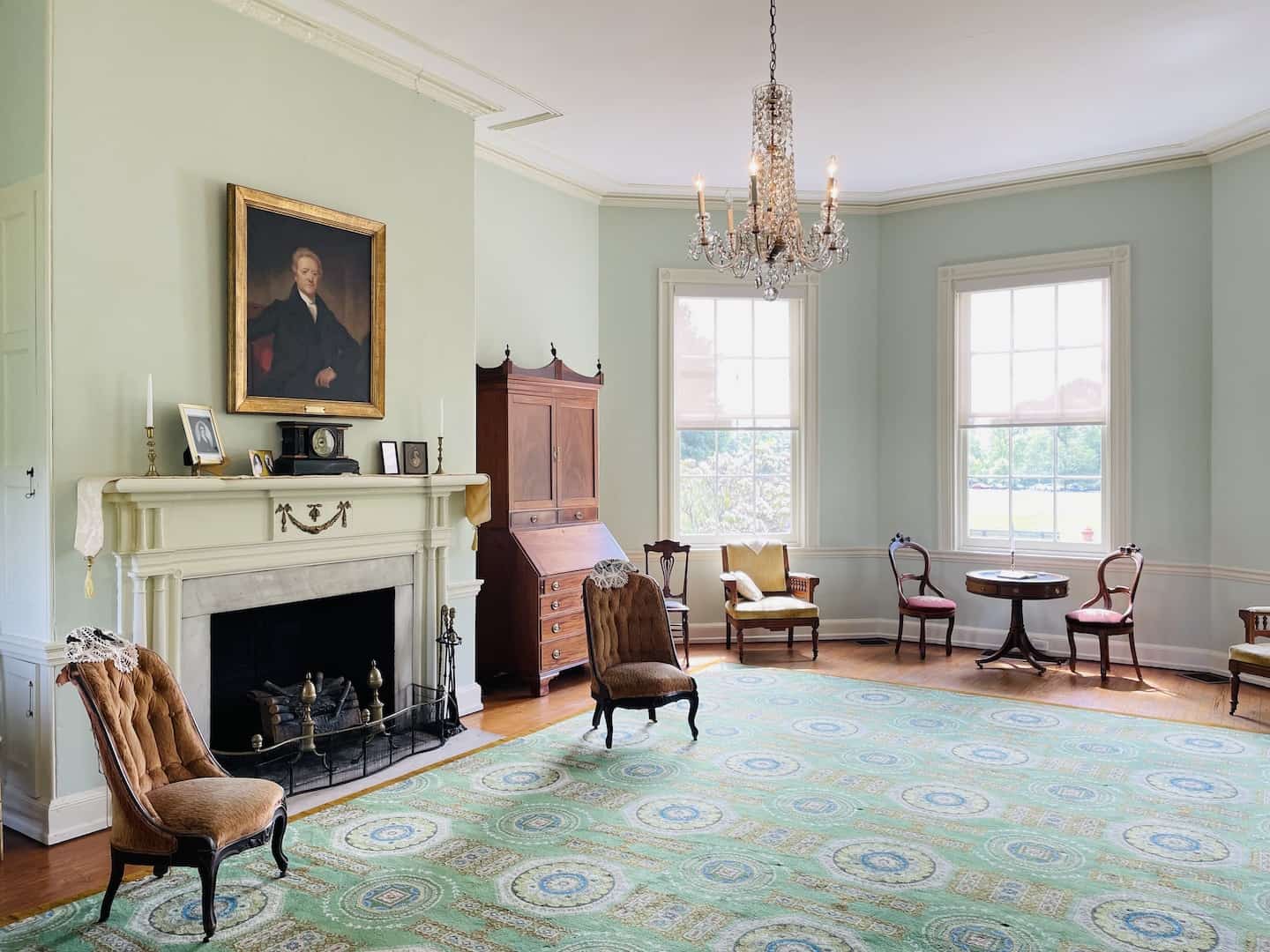
Lemon Hill Mansion
1 Lemon Hill Drive | Currently closed (2023)
Merchant Robert Morris, a founding father and signer of the Declaration of Independence and the U.S. Constitution owned the land in 1770 and dubbed it “The Hills.” He rented out the land for others to farm and built a greenhouse to grow lemons and other plants. Eventually, he sold the land in 1799 due to bankruptcy.
Subsequently, a merchant and real estate investor, Henry Pratt, purchased the land and built the mansion in 1800, calling the structure “Lemon Hill” after the fruit Robert Morris grew on the property. The mansion is built in the Federal style with oval rooms on each floor. Pratt used the house mainly for entertainment and sold it in 1836.
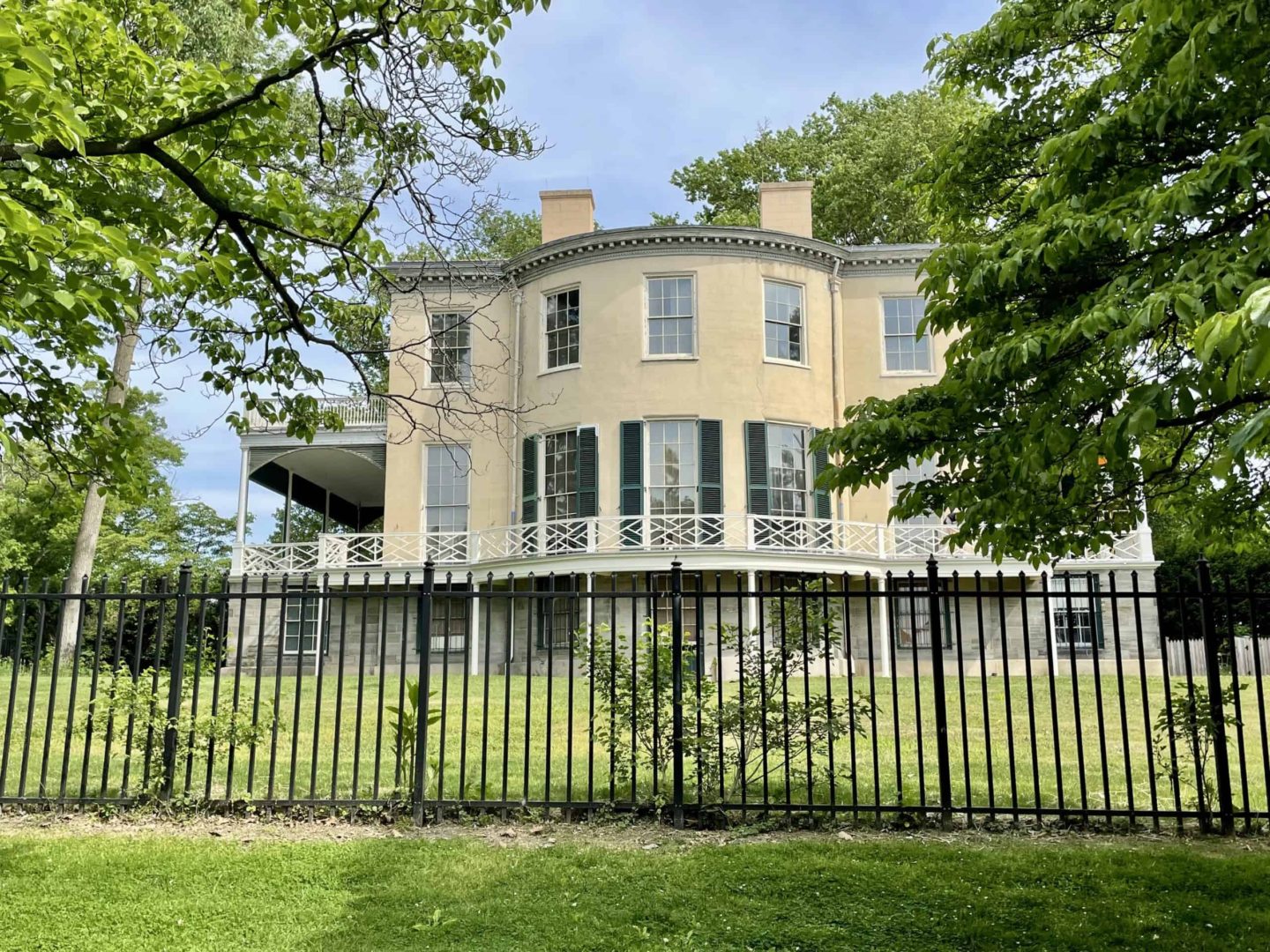
The City of Philadelphia purchased the property in 1844, making it the first private property obtained to form Fairmount Park. Later uses of the property included a beer garden, an ice cream parlor, and restaurants. It was restored in the mid-20th century and later opened to the public.
Note: Lemon Hill Mansion is closed during renovations expected to last into late 2023. Check Lemon Hill’s Facebook page for updated days and hours of operation.
Mount Pleasant
3800 Mount Pleasant Drive | 215-763-8100 (Philadelphia Museum of Art) | Currently closed (2023)
Like other historical mansions in Fairmount Park, Mount Pleasant began as a farm. The Scottish ship captain and privateer John Macpherson purchased the land and built the Georgian-style home in the 1760s. The home’s architect was an apprentice of the builder of Philadelphia’s Independence Hall. When John Adams visited the estate in 1775, he noted it as “the most elegant seat in Pennsylvania.”
Subsequent Mount Pleasant owners include Benedict Arnold (1779), who purchased the property for his second wife (but they never lived there). The first superintendent to West Point and Benjamin Franklin’s grand-nephew, General Jonathan Williams, purchased the property in 1792 and lived there for about 20 years. After his death, the City of Philadelphia purchased the country estate. The Philadelphia Museum of Art restored the property in the 1920s.
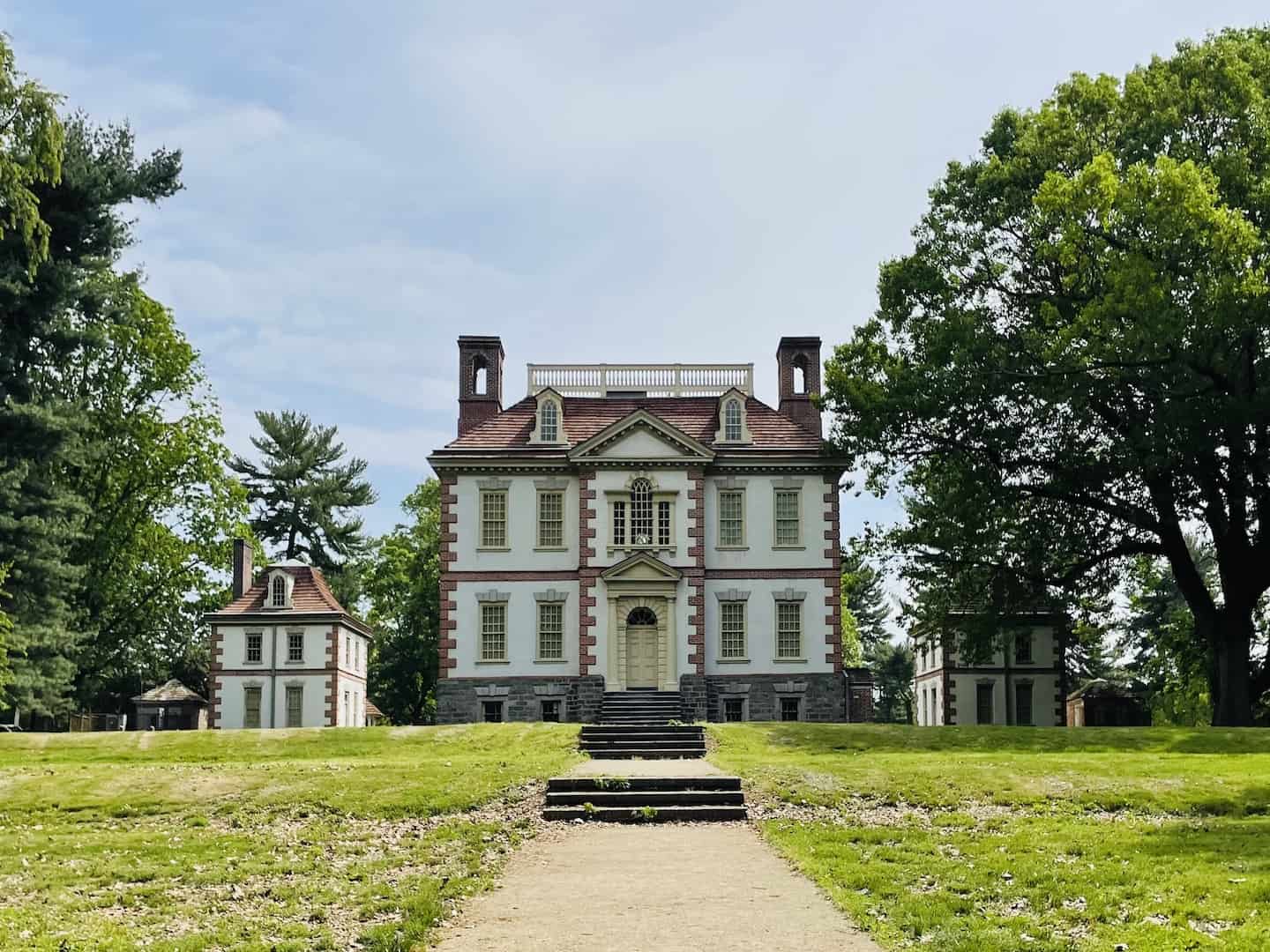
Contact the Philadephia Museum of Art (at the phone number above) to learn more about when the mansion will be re-opened.
Strawberry Mansion
2450 Strawberry Mansion Drive | 215-228-8364 | Open Wednesday-Sunday, 10:00 am-4:00 pm from March through December | Admission fee
Historic Strawberry Mansion is the largest of Fairmount Park’s historic homes. Judge William Lewis, a lawyer and an abolitionist, purchased the property in 1783 and named it Summerville. He built the home in 1789. After his death, Judge Joseph Hemphill, an abolitionist and a member of the House of Representatives, purchased the home in 1821 and later added the two Greek Revival-style wings.
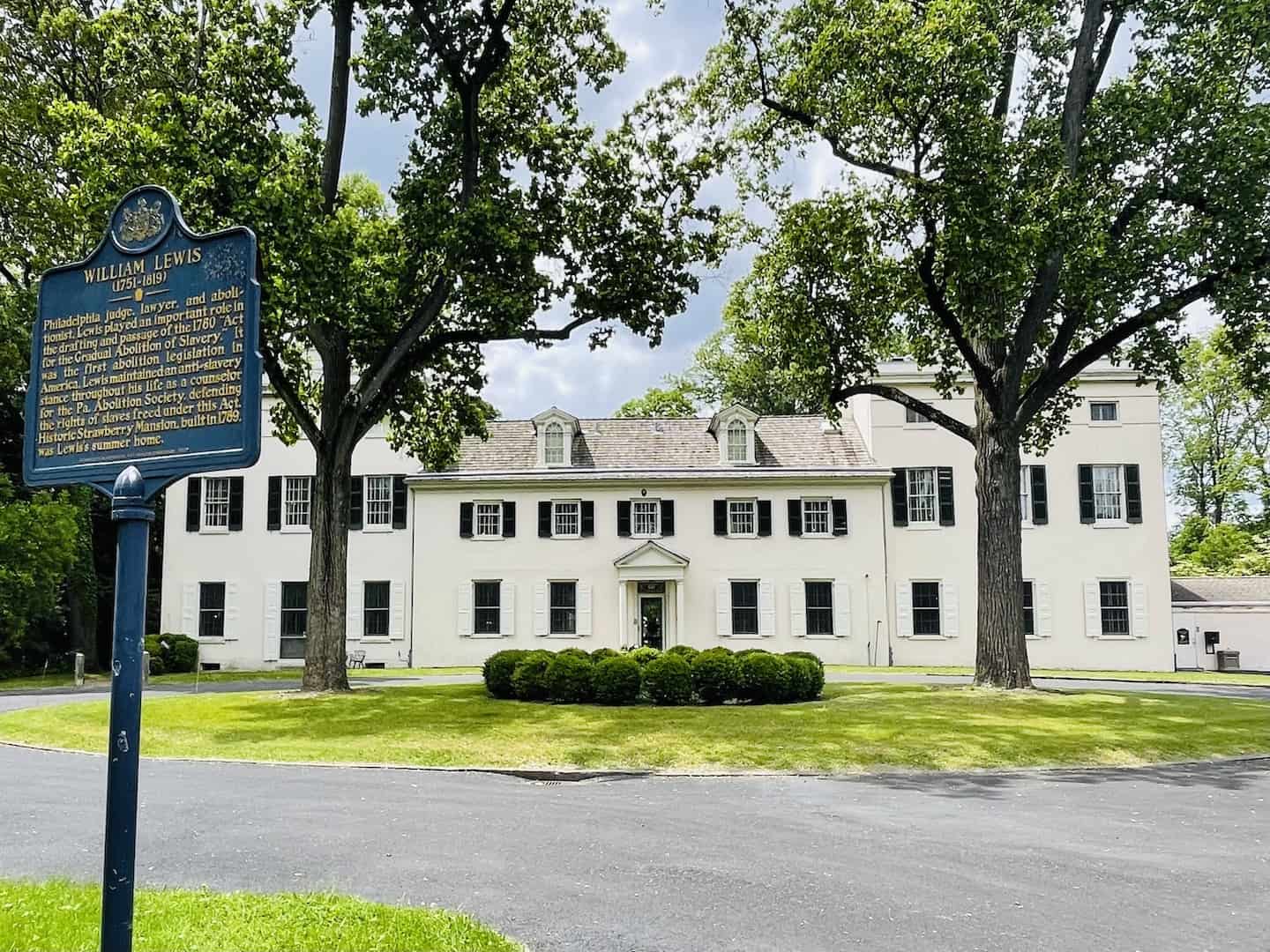
The mansion was restored in the 1930s and opened to the public. Today it is furnished with antiques from the period of its early inhabitants and includes an extensive collection of Tucker Porcelain. The grounds include gardens. A tour includes the first and second floors.
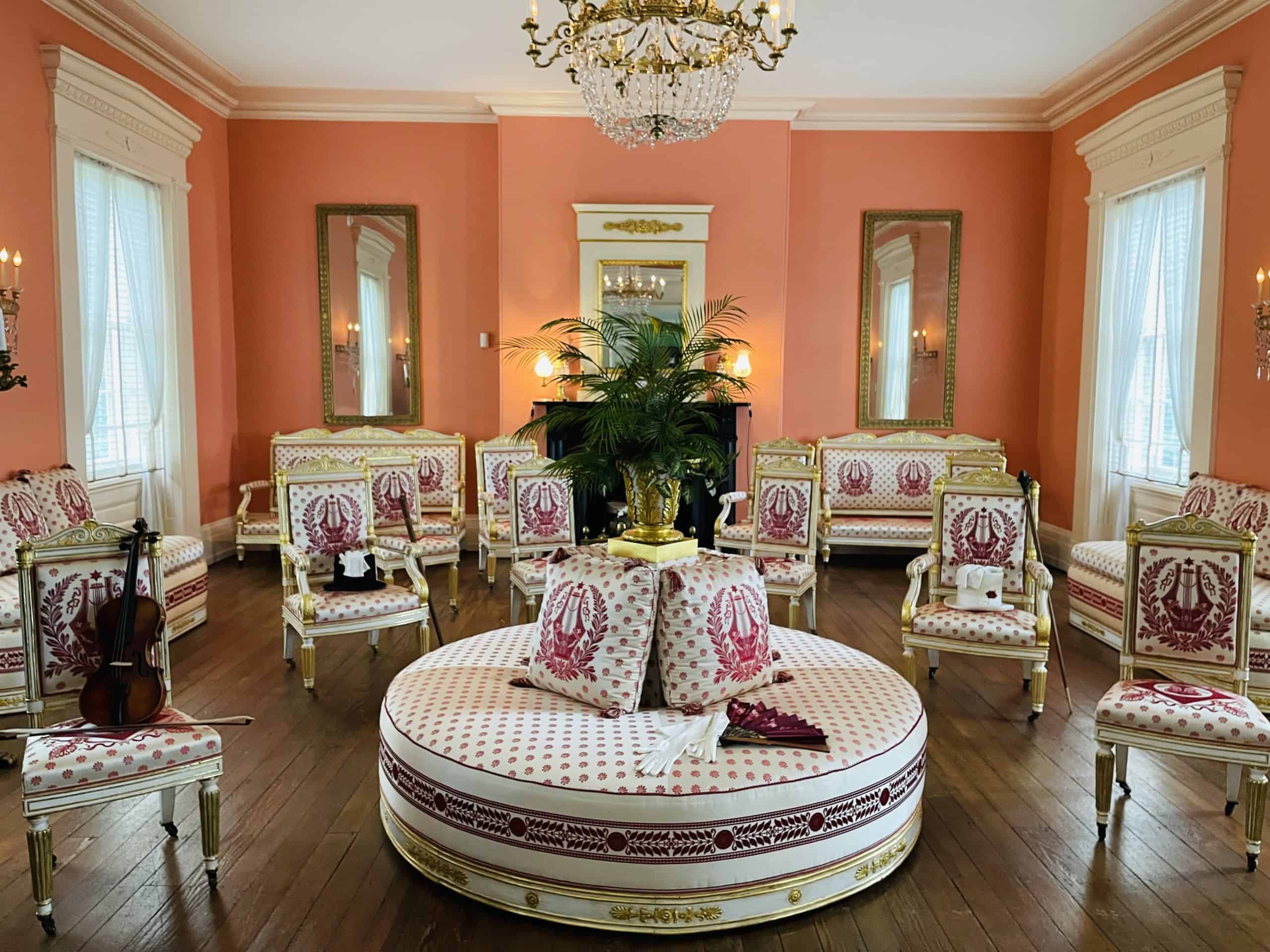
Woodford Mansion
2300 North 33rd Street | 215-229-6115 | Open year-round Wednesday-Sunday; 10:00 am-4:00 pm (closed some holidays) | Admission fee
Woodford began as a small farmhouse but was enlarged in 1758 for William Coleman, a Philadelphia merchant and judge and one of Ben Franklin’s close friends. Following his death, David Franks purchased the property in 1771. Franks was an agent for the British government and purchased supplies for their army stationed in America. To accommodate his family and for entertainment purposes. Franks added a story to the home as well as a two-story addition on the back of the house. Because of their British Loyalist position, the Americans forced the Franks family to flee to England.
In 1793 Isaac Wharton purchased Woodford as a summer retreat for his family. The City of Philadelphia purchased the property to add to Fairmount Park in 1868.
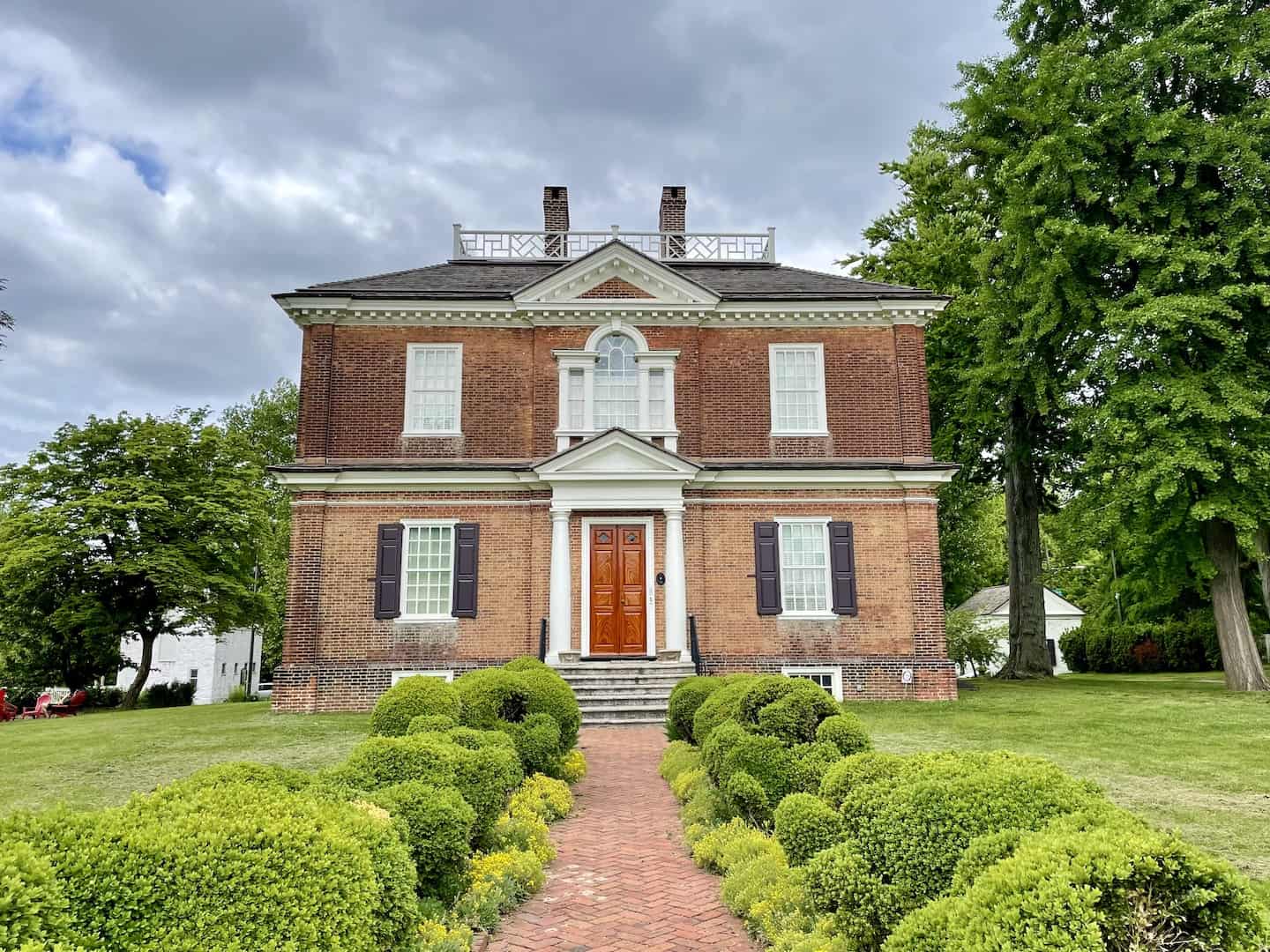
Comprehensive Collections
Today’s visitors to Woodford will enjoy the extensive collection of period art, home decor, and household items (including an interesting array of miniatures) from the Naomi Woods collection that furnish the mansion. Interested in history, Woods (along with her friend Daniel Huntoon) was an avid collector and wanted their acquisitions to be used to furnish a historical house, thereby ensuring that visitors could appreciate the art, decor, and other artifacts of the American colonial era. A tour includes the first and second floors.
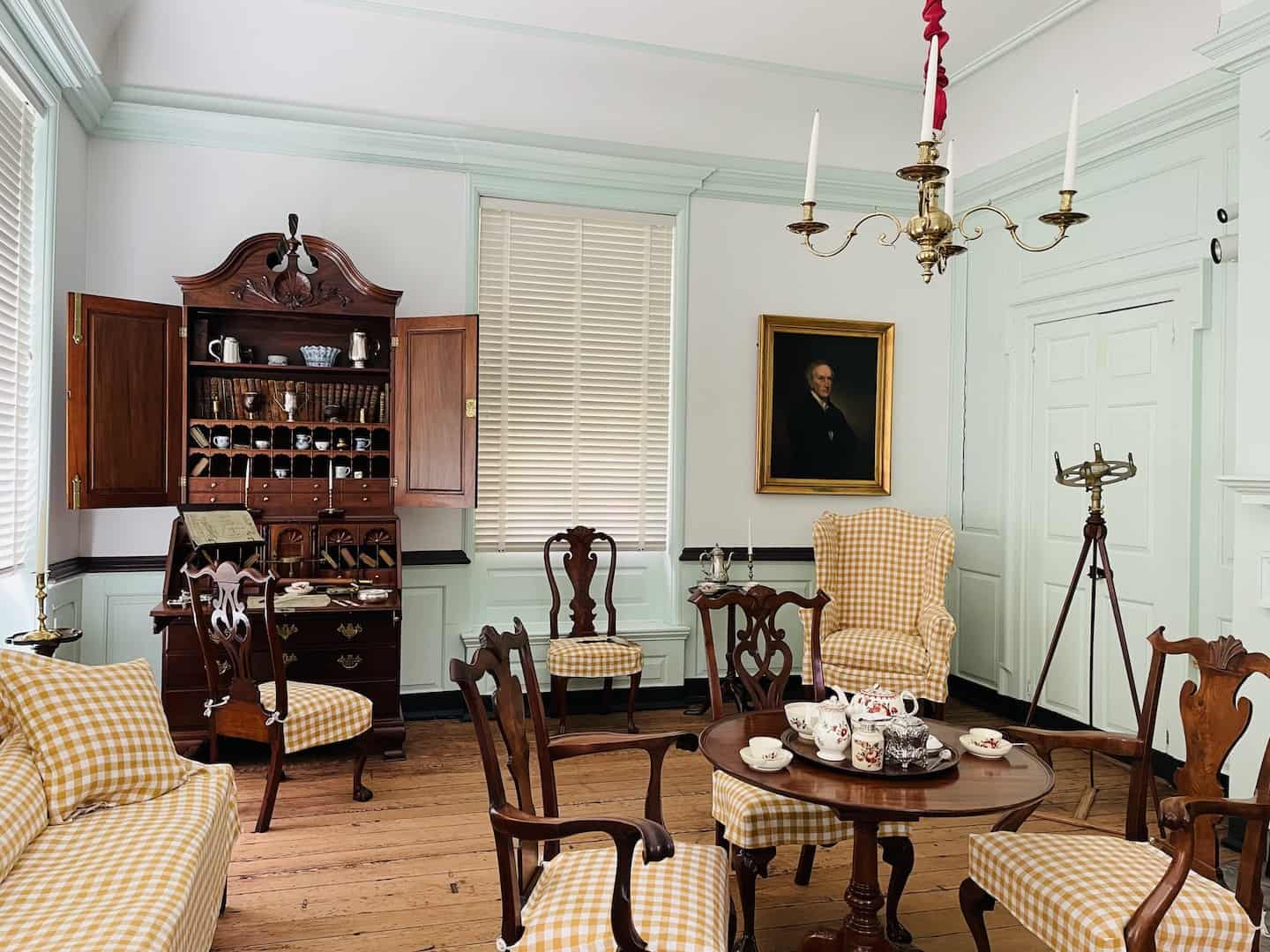
Schuylkill River Connection
Interestingly, the property’s name, Woodford, has nothing to do with its occupants or their interests. Instead, it’s derived from the fact that folks would refer to this area as where the ford near the woods was, as there was a section of the Schuylkill River that was shallow enough to be forded without a boat. This predates the establishment of the Fairmount Water Works (and the dam) were built in the early 1800s as a water pumping station for Philadelphia.
Accessing the Mansions
Most visitors will visit the mansions by driving from one to another. Another choice is to visit some of them on foot, enjoying nature along the way: walking Boxer’s Trail. This 4.3-mile trail winds through Fairmount Park from next-door neighbors Strawberry Mansion and Woodford Mansion (where there’s a trailhead) to Laurel Hill Mansion and Mount Pleasant Mansion. (The trail continues to a dirt path near the Lemon Hill mansion.) Stroll back to your car and consider visiting other nearby Fairmount Park sights, like Laurel Hill Cemetery.
Visitor Tips
- Before visiting, check online or call the mansion’s property manager (like the Philadelphia Museum of Art) to verify the current days and hours of operation. Besides periodic temporary closures, some places may be closed due to private functions.
- Free parking is available at or near each historical mansion, either on the street or on the property itself.
- Admission is charged at the mansions and includes tours.
- A few of the country homes along the Schuylkill River are open to visitors, while some are temporarily closed while undergoing renovations or haven’t reopened since the COVID pandemic. Despite some homes being closed to the public, visitors can still view all the structures and walk around the properties.
- Several mansions decorate for the holidays and offer special visiting hours in November and December.
Other Fairmount Park Highlights
Boathouse Row
1 Boathouse Row | Free
Stroll, bike, or run along the paved Schuylkill River Trail by Boathouse Row (15 buildings housing social and rowing clubs) and the scenic river vistas and the city skyline. There are plenty of grassy areas to stop and enjoy the views or have a picnic. Note that there is no admittance to any of the Boathouse Row buildings.
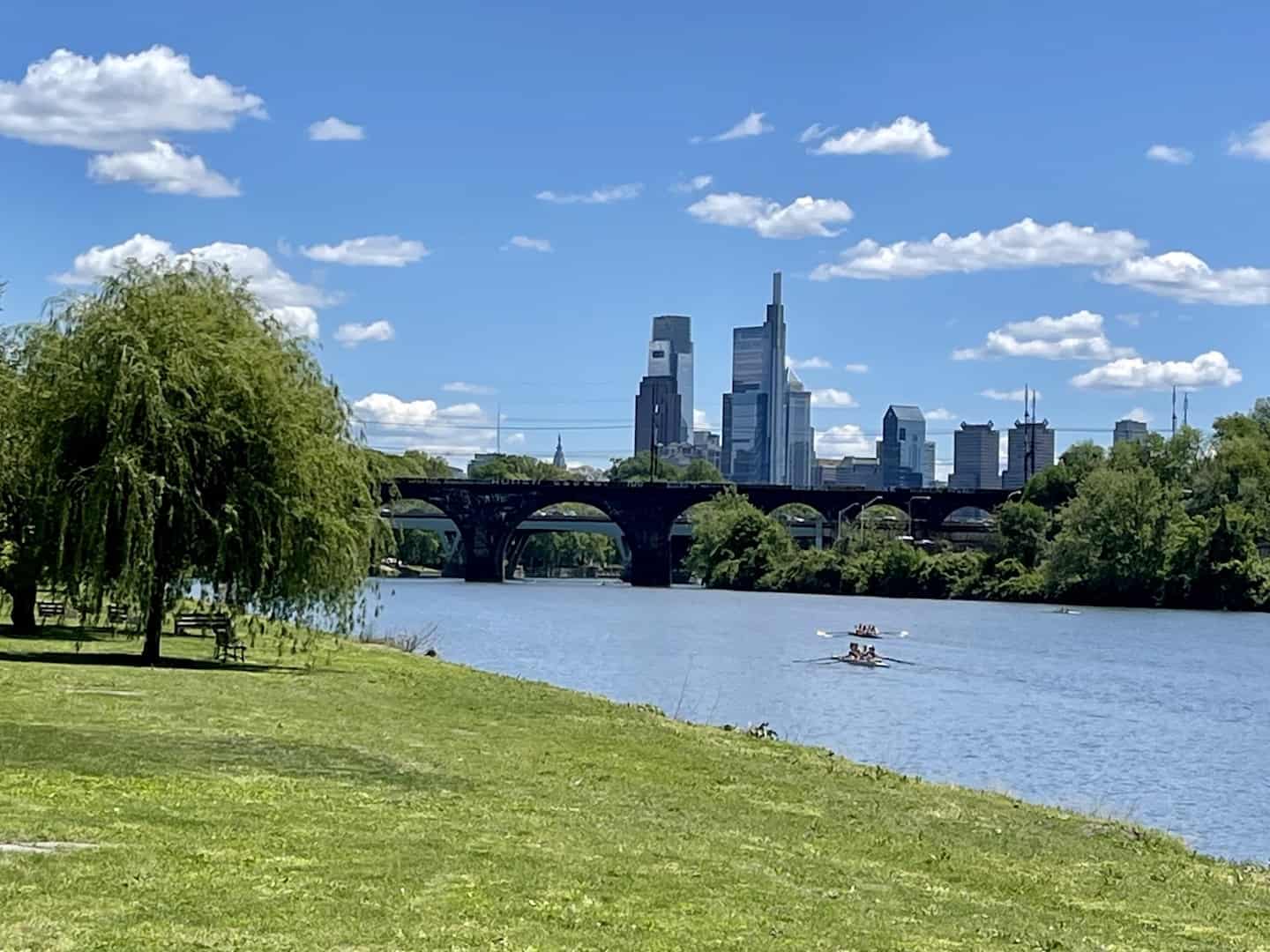
Fairmount Park Horticultural Center
100 North Horticulture Drive | 215-988-9334 | Free
A large greenhouse, demonstration gardens, a reflecting pool, a gazebo, a butterfly garden, and trails are the highlights at the Horticultural Center in Fairmount Park. Although the greenhouse is open Monday-Saturday year-round from 8:00 am to 5:00 pm (excluding holidays), the grounds are open for extended hours. Leashed dogs are welcome on the trails. Parking for bikes and cars is free.
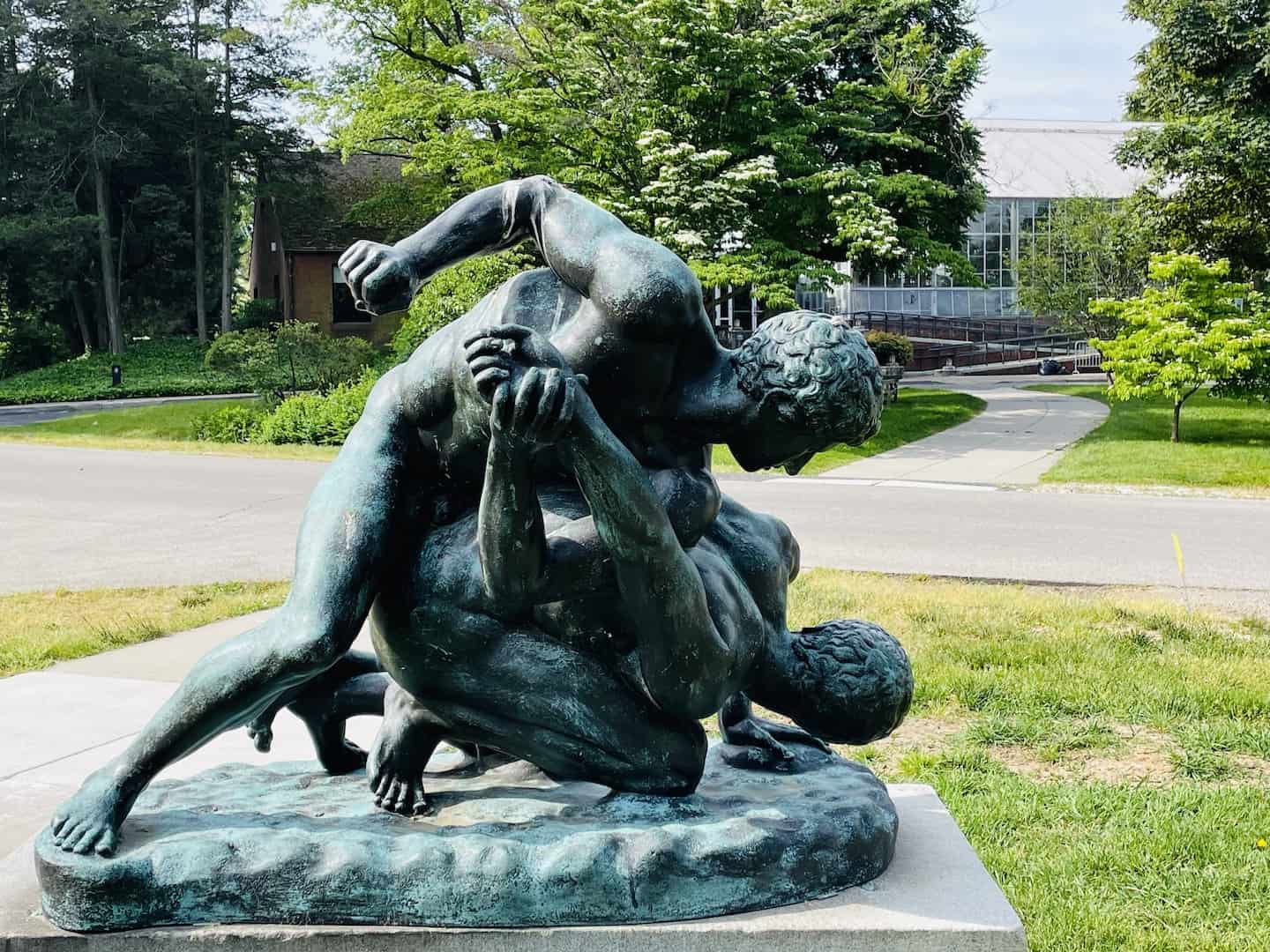
Laurel Hill Cemetery
3822 Ridge Avenue | 610-668-9900 | Free
Picture a stroll through a hilltop with meandering paths and careful placement of trees and flowering shrubs – and thousands of graves. That’s what awaits visitors to Laurel Hill Cemetery. It is a burial ground established in 1836 as a rural cemetery, a relatively new concept of the time, located three miles from the city’s original footprint. The idea was to have the space for families to be laid to rest together outside what was becoming a growing, crowded urban area. Today it attracts thousands of visitors (for walking, biking, running, and picnicking) and hosts tours and events for the public.
Visiting the cemetery reflects history as there are graves of notable artists, athletes, inventors, politicians, military leaders, physicians, and many more common folks. Among them are the graves of General George Meade (1815-1872), a Civil War general; Titanic survivors; and Harry Kalas (1936-2009), a Hall of Fame Philadelphia Phillies broadcaster. In addition to pondering those buried here, visitors can gain an appreciation for the unique plantings and views of the Schuylkill River. Laurel Hill Cemetery became a National Historic Landmark in 1998.
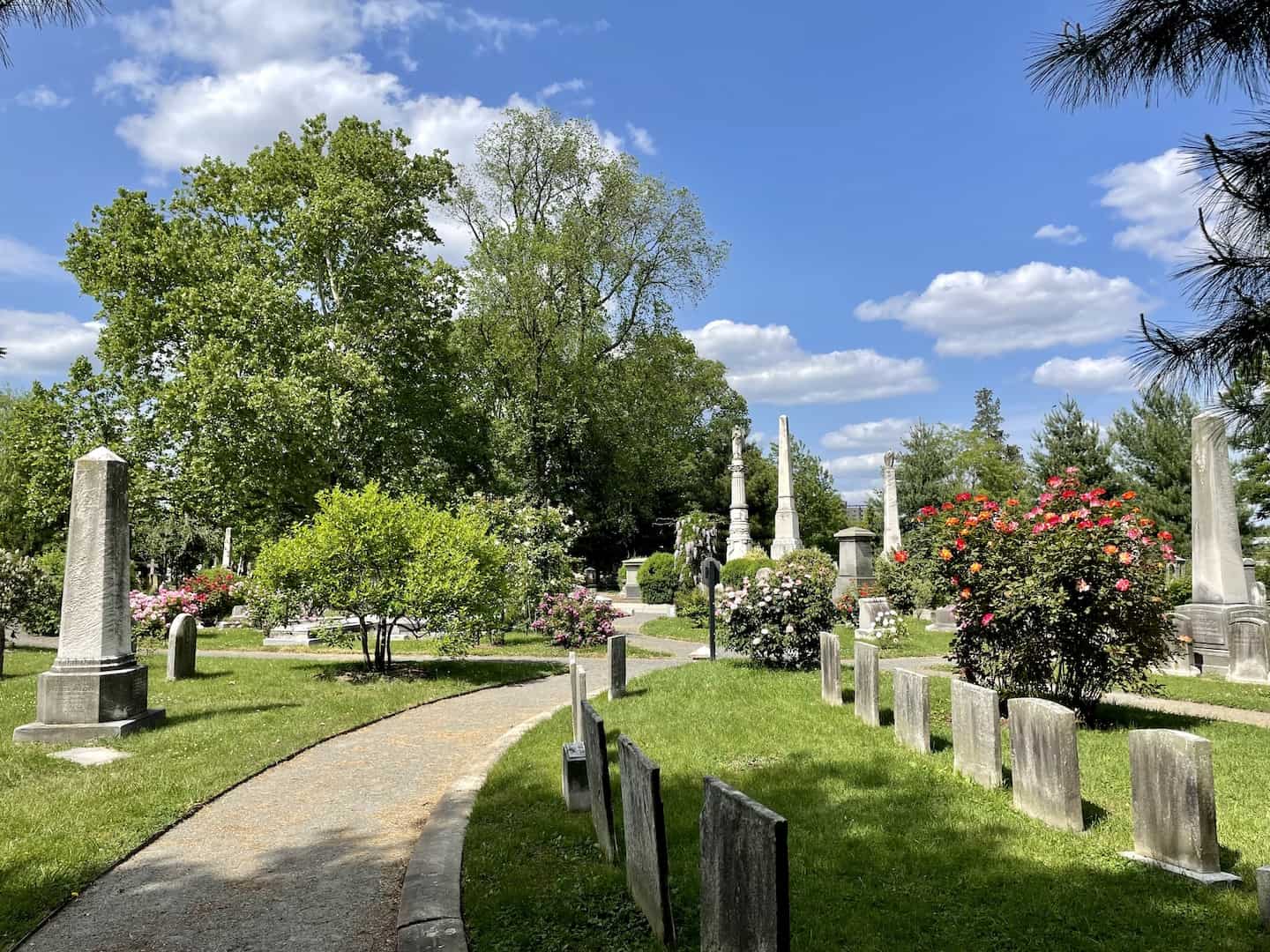
Another related cemetery, Laurel Hill West, is in Bala Cynwyd, PA. The two properties (combined) have a 265-acre arboretum, many outdoor sculptures, and over 30,000 graves.
Note: There is limited parking within the cemetery gates of Laurel Hill Cemetery East on Ridge Avenue, though free on-street parking is available nearby.
Philadelphia Museum of Art
2600 Benjamin Franklin Parkway | 215-763-8100 | Open Thursday-Monday, closed Tuesday and Wednesday | Admission fee
The Philadelphia Museum of Art displays predominantly American, European, and Asian art, with over 240,000 pieces in its collection. It oversees two historic homes in Fairmount Park: Cedar Grove and Mount Pleasant. (It’s also home to the famed Rocky statue!)
Philadelphia Zoo
3400 W Girard Avenue | 215-243-1100 | Open daily | Admission fee
Visit the country’s first zoo that houses and cares for thousands of animals – including some rare and endangered species.
Please Touch Museum
4231 Avenue of the Republic | 215-581-3181 | Open Wednesday-Monday, closed Tuesday | Admission fee
This family-friendly museum allows kids and their adults to explore engaging hands-on exhibits.
Public Art
Visitors will see plenty of public art throughout Fairmount Park. I like to take a moment to view the art and read the inscriptions to be reminded of the contributions of so many talented people.
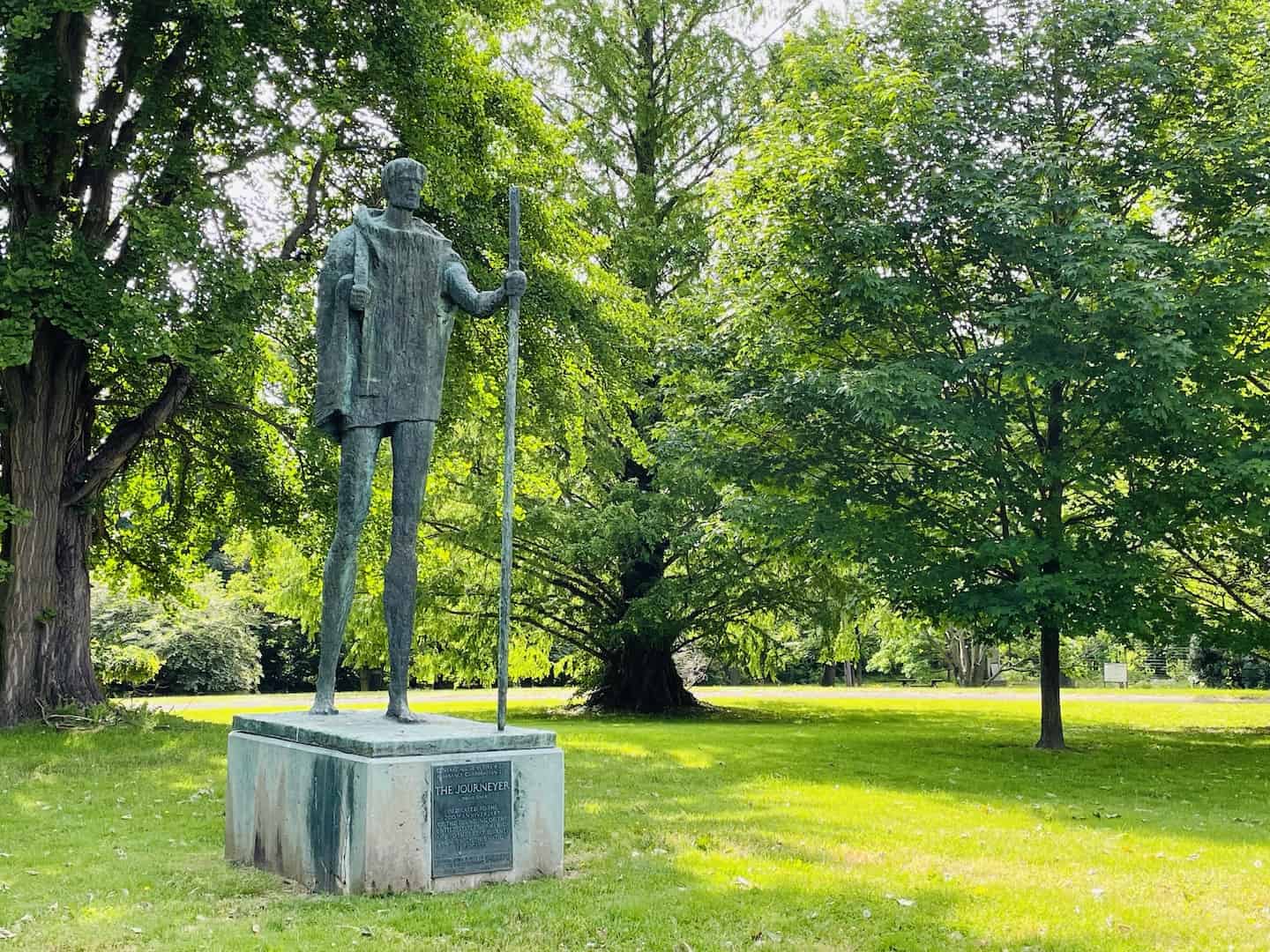
Shofuso Japanese Cultural Center
West Fairmount Park, Horticultural and Lansdowne Drives | 215-878-5097 | Open spring to late fall; times vary by season | Admission fee
Shofuso is a traditional Japanese home with landscaped gardens surrounding a pond. Originally built in Japan in 1953, it found its home in Fairmount Park in 1958. Expect to spend about an hour touring the property. Order timed tickets online. Free parking.
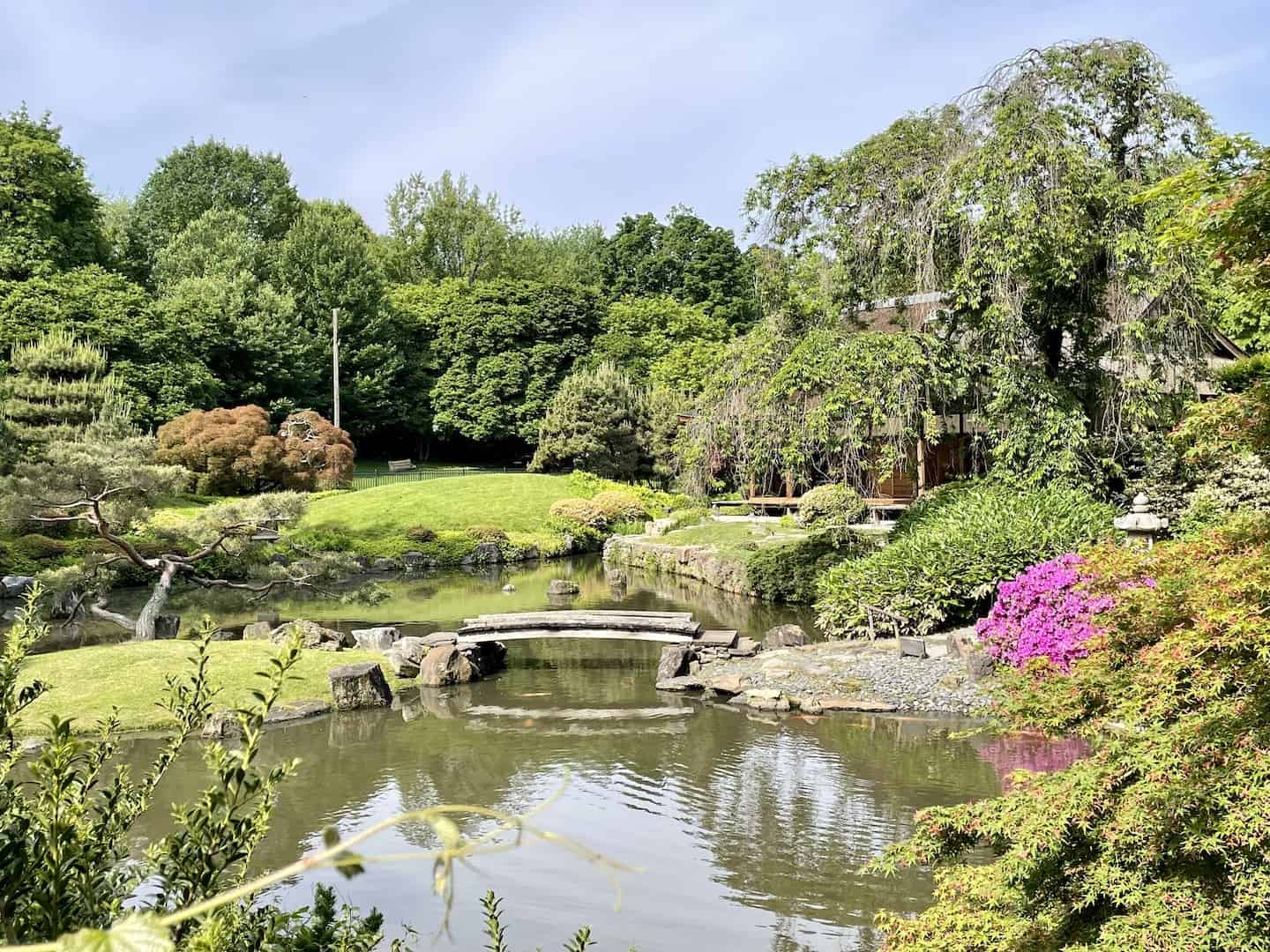
Trails
Three popular trails take walkers and runners along scenic spots: Boxer’s Trail connects several historic mansions, the Schuylkill River Trail hugs the river’s east bank, and the Trolley Trail in the park’s western section.
Boxer’s Trail is a 3.8-mile out-and-back gravel and paved trail, considered easy, with an elevation gain of 253 feet. In East Fairmount Park, the trail passes several historical mansions mentioned in this article (Mount Pleasant Mansion, Laurel Hill Mansion, Strawberry Mansion, and Woodford Mansion). There’s parking near Mount Pleasant Mansion at 3800 Mount Pleasant Drive.
Schuylkill River Trail hugs the river’s east bank and is quite scenic. The trail has grassy areas along the waterfront with some benches and is a great place for a picnic. In addition, the trail passes Boathouse Row. (Rental bikes are available at Wheel Fun Rentals at 1 Boathouse Row if you want to explore the area on two wheels.) The trail extends 25 miles from Philadelphia to Phoenixville, but the section along the river between the Philadelphia Museum of Art and north along Kelly Drive is not to be missed if you like to walk, run, or bike. Parking is limited along Kelly Drive, so arrive early to claim a spot.
Trolley Trail is a 4-mile loop trail for hiking and biking, considered moderate, with an elevation gain of 360 feet. Located in West Fairmount Park, the trailheads are at the Chamounix Hostel and along the southern edge of Chamounix Drive. The trail is considered moderate and passes under an old brick tunnel.
Nearby Attractions
- Colonial PA Plantation, outside Philadelphia
- Covered Bridges of Bucks County, PA
- John Heinz National Wildlife Refuge, outside Philadelphia
- Museum of the American Revolution (Philadelphia): A Visitor’s Guide
- Philadelphia: A Self-Guided Walking Tour in History’s Footsteps
- Ridley Creek State Park, outside Philadelphia
- Tyler State Park: Tempting Trails and Tales
- Valley Forge National Historical Park: Sensational Scenery and Historic Sites
- Washington Crossing Historic Park
Final Thoughts
A trip to Philadelphia is also a welcome treat for me. In addition to the Old City with all its significant buildings and history, Fairmount Park has its vast acreage and lovely historic mansions from the 19th century.
In the past, I’ve enjoyed walks along Kelly Drive along the grassy river bank, by Boathouse Row, and on to the Philadelphia Museum of Art.
On this visit to Fairmount Park, I enjoyed my tours of the three 18th-century homes that are currently open (Laurel Hill, Strawberry Hill, and Woodford). The tour guides effectively highlighted the families as well as their homes (and decor and furnishings), and it was fascinating to learn more about this city’s colonial history. There are even more attractions nearby in the park to explore.
Laurel Hill Cemetery is quite a peaceful place to slow down, meander the beautifully landscaped grounds, and soak in the hilltop views of the Schuylkill River. I didn’t purposely seek the graves of famous people, but that’s always an option. However, I did happen upon General Meade’s grave, which was festooned with red, white, and blue wreaths. Expect to see simple gravestones along with elaborate monuments representing the variety of social stature, wealth, and fame of those interred here.
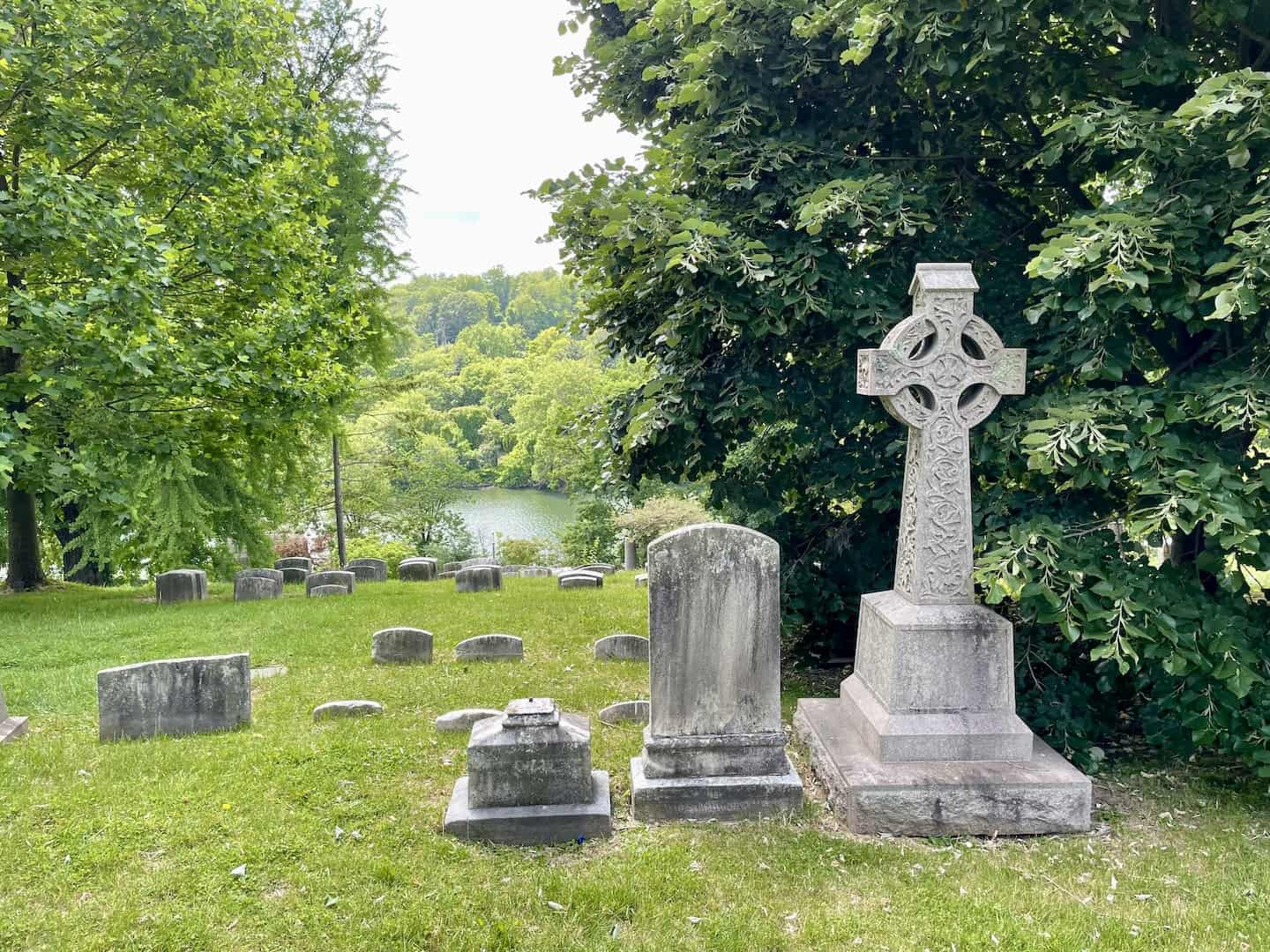
Leaving the eastern part of Fairmount Park, I drove to the other side of the river to explore Horticulture Park, the Japanese Shofuso house, and other nearby spots. All in all, Fairmount Park provides attractions and recreational opportunities for Philadelphia residents and visitors alike.
Comments?
Feel free to leave ideas or suggestions for visiting Fairmount Park and enjoying its attractions. Your thoughts could help other travelers. Thanks! 🙂

